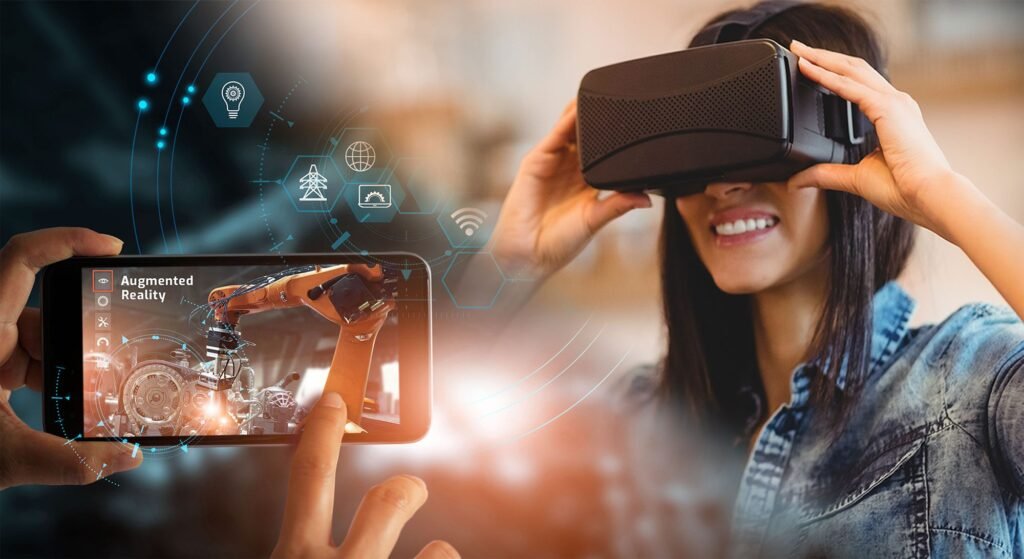Beyond Reality: Unveiling the Potential of Augmented Reality (AR) and Virtual Reality (VR)
In the ever-evolving landscape of technology, Augmented Reality (AR) and Virtual Reality (VR) stand as transformative pillars, transcending the boundaries of our physical reality. These immersive technologies have captured the imagination of industries and consumers alike, promising to reshape the way we work, learn, play, and connect. This article delves into the captivating realms of AR and VR, exploring their definitions, applications, impact on diverse sectors, and the boundless possibilities they bring to our digital future.
I. Introduction
A. Defining Augmented Reality (AR) and Virtual Reality (VR)
Augmented Reality (AR) overlays digital information onto the real world, enhancing our perception by blending the physical and virtual. On the other hand, Virtual Reality (VR) immerses users in a completely digital environment, disconnecting them from the physical world and transporting them to a simulated reality.
B. The Rise of Immersive Technologies
The journey of AR and VR from niche concepts to mainstream technologies has been marked by advancements in hardware, and software, and a growing appetite for immersive experiences. These technologies are no longer confined to the realm of entertainment; they are catalysts for innovation across various domains.
II. Key Components of AR and VR
A. Augmented Reality (AR) Components
- Sensors:
- Utilizing cameras, GPS, accelerometers, and gyroscopes to interpret the real-world environment.
- Enabling AR devices to understand and respond to user interactions.
- Display Technology:
- Overlapping digital content onto the physical world through devices like smartphones, smart glasses, or AR headsets.
- Creating a seamless integration of virtual and real elements.
B. Virtual Reality (VR) Components
- Headsets and Immersive Displays:
- VR headsets block out the physical world and immerse users in a digital environment.
- High-resolution displays and advanced optics for a lifelike VR experience.
- Motion Tracking:
- Tracking the user’s movements in real-time to replicate them in the virtual space.
- Enhancing user engagement and interaction within the VR environment.
III. Applications Across Industries
A. Augmented Reality (AR) Applications
- Retail and E-Commerce:
- AR for virtual try-ons and visualizing products in the real world.
- Enhancing the online shopping experience with interactive elements.
- Healthcare:
- AR for medical training, surgery planning, and visualizing patient data.
- Improving accuracy and efficiency in healthcare procedures.
B. Virtual Reality (VR) Applications
- Gaming and Entertainment:
- Immersive VR gaming experiences that transport players to alternate realities.
- VR cinema and storytelling for a new dimension of entertainment.
- Education and Training:
- VR simulations for hands-on training in fields such as aviation, healthcare, and manufacturing.
- Virtual classrooms and educational experiences to enhance learning.
C. Industrial and Enterprise Use
- Manufacturing and Design:
- VR for virtual prototyping and product design.
- Streamlining collaboration and decision-making in industrial processes.
- Remote Collaboration:
- AR for remote assistance, enabling experts to guide and support technicians from a distance.
- VR for immersive virtual meetings and collaboration among global teams.
IV. Impact on User Experience
A. Enhanced Engagement
- Immersive Storytelling:
- VR’s ability to transport users into the narrative of a story.
- Creating a deeper emotional connection and engagement.
- Interactive Learning:
- AR’s interactive overlays in educational content.
- Fostering active participation and deeper understanding.
B. Improved Training and Skill Development
- Simulated Environments:
- VR simulations for training in high-risk environments.
- Accelerating skill development with realistic scenarios.
- On-the-Job Support:
- AR provides real-time guidance and information during tasks.
- Reducing errors and improving efficiency in various professions.

V. Challenges and Considerations
A. Technical Challenges
- Hardware Limitations:
- The need for powerful and affordable AR and VR devices.
- Overcoming constraints related to weight, size, and processing power.
- Motion Sickness and Discomfort:
- Addressing user discomfort and motion sickness in VR experiences.
- Improving technologies to reduce latency and enhance user comfort.
B. Content Creation and Standardization
- Content Diversity:
- Ensuring a wide variety of quality content for AR and VR.
- Encouraging content creators to explore diverse genres and applications.
- Industry Standards:
- Establishing standards for AR and VR hardware and software.
- Facilitating interoperability and a more cohesive user experience.
VI. The Future of AR and VR
A. Advancements in Technology
- 5G Connectivity:
- The role of high-speed, low-latency 5G networks in enhancing AR and VR experiences.
- Enabling more seamless and responsive interactions.
- Haptic Feedback and Sensory Integration:
- Advancements in haptic technology for realistic touch sensations in VR.
- Integrating additional sensory experiences for a more immersive feel.
B. Integration with Emerging Technologies
- Artificial Intelligence (AI):
- AI-driven enhancements in content personalization and user interactions.
- Creating more intelligent and adaptive AR and VR experiences.
- Internet of Things (IoT):
- Integrating AR and VR with IoT for a more connected and responsive environment.
- Enhancing the synergy between digital and physical elements.
VII. Conclusion
A. Unveiling the Boundless Horizons
- A New Era of Interaction:
- Reflecting on the transformative impact of AR and VR on human interaction with digital and physical worlds.
- The paradigm shift in how we perceive and engage with information and experiences.
- The Evolution Continues:
- Recognizing that the journey of AR and VR is an ongoing exploration.
- The potential for these technologies to redefine industries, learning, and entertainment in ways yet to be imagined.
As Augmented Reality and Virtual Reality continue to blur the lines between reality and imagination, their influence on our daily lives and industries is profound and expanding. The marriage of virtual and physical realms opens doors to unprecedented possibilities, from revolutionizing how we shop to reshaping the way we train professionals in high-stakes environments. The future promises not just technological advancements but a redefinition of human experience, where the real and the virtual seamlessly coexist, creating a tapestry of immersive and enriched realities.